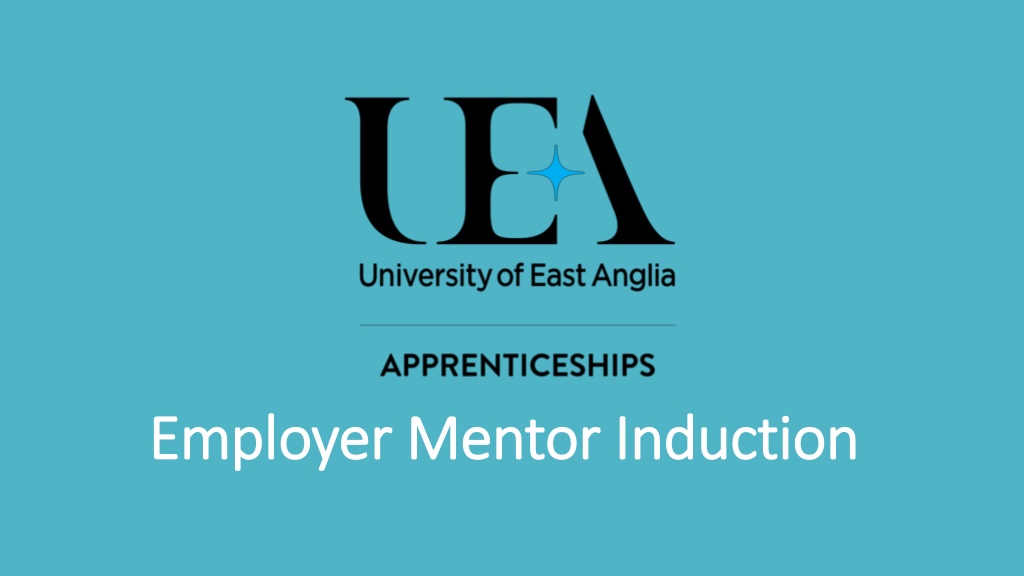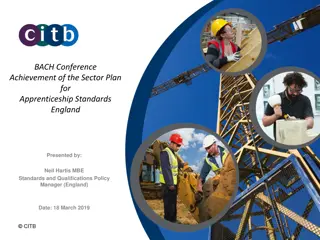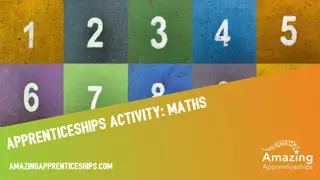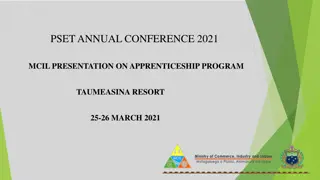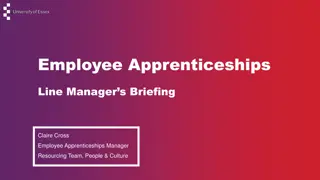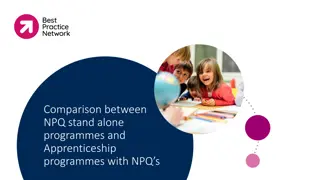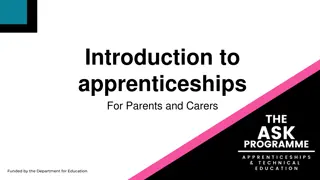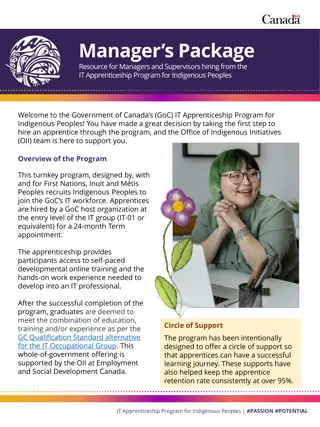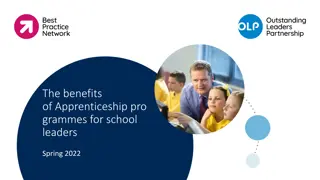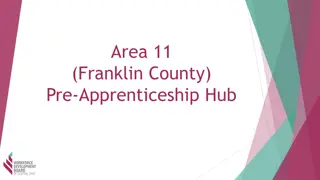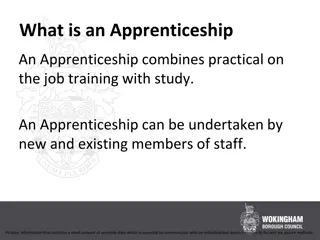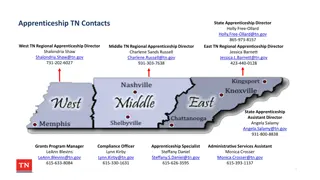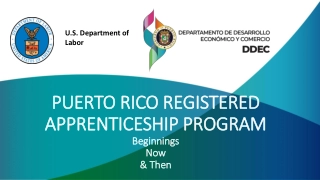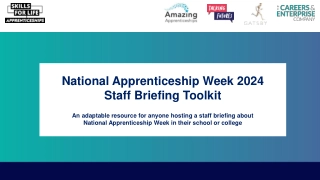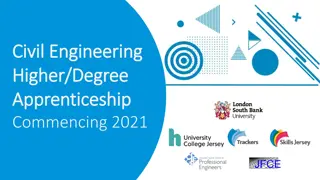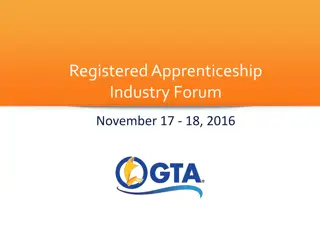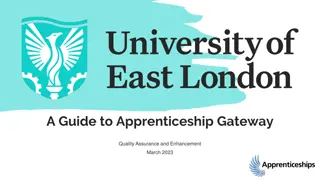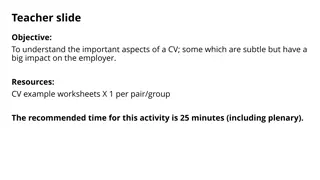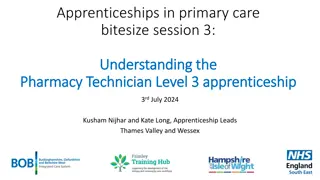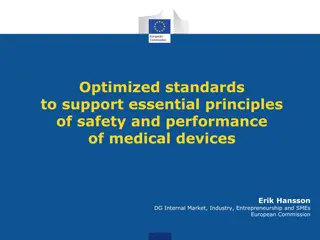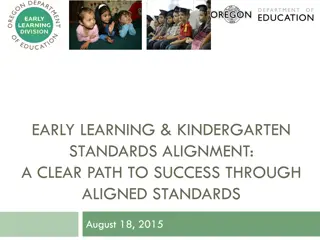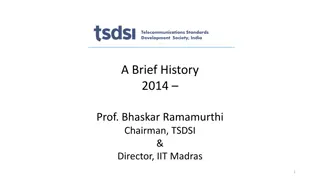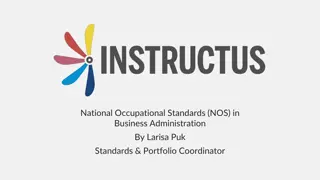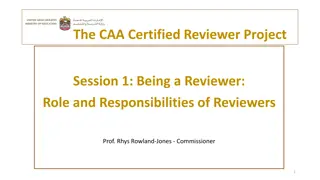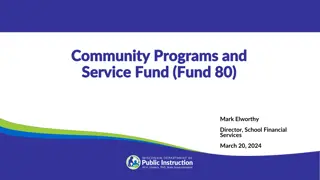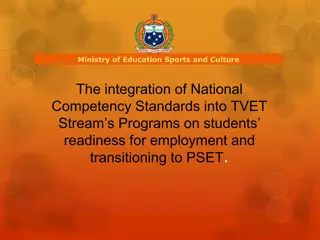Understanding Apprenticeship Standards and Development Programs
Explore the structure and components of apprenticeships, understand the role requirements, and engage confidently in supporting apprentices' progress. Learn about apprenticeship standards, knowledge, skills, behaviors, and personal & professional development opportunities within the program.
Download Presentation

Please find below an Image/Link to download the presentation.
The content on the website is provided AS IS for your information and personal use only. It may not be sold, licensed, or shared on other websites without obtaining consent from the author. Download presentation by click this link. If you encounter any issues during the download, it is possible that the publisher has removed the file from their server.
E N D
Presentation Transcript
Employer Mentor Induction Employer Mentor Induction
Purpose To be able to: Familiarise yourself with the structure and different components of an apprenticeship Relate the requirements of apprenticeships to your own role Confidently engage in all requirements of an apprenticeship such as progress reviews to support the apprentice
Organisation and Management of the Apprenticeship Apprenticeship Structure The Apprenticeship Standard covers the knowledge, skills and behaviours deemed necessary for the specific occupation of the apprenticeship The Apprenticeship is complete once the End Point Assessment has been completed The length of degree apprenticeships varies from programme to programme Teaching is concentrated around two semesters, although this may vary for some programmes On the apprenticeship the apprentice will normally complete taught modules and assessed work- based learning The focus on work-based learning allows the apprentice to apply and practice the taught elements of the programme
Apprenticeship Standards Each apprenticeship is designed to ensure that an apprentice achieves a set of Standards relevant to the industry in which they are employed. https://www.instituteforapprenticeships.org/apprenticeship-standards/ The Standards of an apprenticeship are developed by employers in the industry Each Apprenticeship Standard is based on an occupational profile of the role and responsibilities of a particular level of work - knowledge, skills and behaviours (KSBs) The apprentice is required to demonstrate competency against the KSBs in order to complete the apprenticeship
Knowledge, Skills and Behaviours (KSBs) The taught programme is designed to support the apprentice achieving the Standards (knowledge, skills and behaviours) of the apprenticeship. The knowledge criteria relate to the theoretical learning undertaken in the apprenticeship The skills will be covered through the practical application of the knowledge acquired in this apprenticeship The behaviours relate to attitude, mindset, outlook and how the apprentice works. Some of the Apprenticeship Standards refer to Duties and the KSBs are separated out across the Duties .
Personal & professional Development (PPD) The apprenticeship programme provides opportunities to demonstrate Personal and Professional Development (PPD) The PPD requirements align to the KSBs and provide opportunity to develop attributes beyond the academic requirements of your occupation, including: Confidence in participating in public life; Understanding the fundamental British Values of democracy, individual liberty, the rule of law and mutual respect and tolerance; Being open and inclusive towards people from all characteristics; Developing robust and positive personal traits; Being aware of own mental and physical health; Having a clear career path.
Off the Job Training & Attendance A minimum of 20% of your contracted hours should be allocated to off the job training Off the job training should be used in any of the following areas: Theory learning (knowledge), i.e., lectures, seminars, workshops, online learning, simulation exercises or relevant employer training and coaching; Practical training (skills and behaviours), including things that an apprentice wouldn t normally do in a typical week at work. For example, shadowing, relevant new skills training, mentoring, coaching, CPD activities, meetings; Learning support and time spent writing assignments and completing module assessment activities. Attendance - It is essential that attendance is monitored and recorded Any non-attendance of course sessions will impact on achievement of the OTJ hours; Time will need to be made up.
Planning Learning The Apprentice must set aside time for study outside the scheduled sessions to meet the off-the-job training requirements for the apprenticeship. Including: Familiarising themselves with Blackboard; Reading around the subject; Being aware of current research and findings; Participating in any discussions, blogs or forums; Complete independent study activities set by course tutors.
End Point Assessment End-point assessment (EPA) is the final stage of an apprenticeship. It is an impartial assessment of achievement of the Apprenticeship Standard. The apprentice will complete the EPA when the employer is content that they have attained sufficient skills, knowledge and behaviours as detailed in the apprenticeship standard. Before doing the EPA the apprentice must have met a threshold, known as the Gateway : Completed an academic award (degree) or the specified number of credits; Met the minimum duration of the apprenticeship.
Apprenticeship Advisors Each apprentice will be allocated an Apprenticeship Adviser. The role is to: Be a Apprenticeship Advisor; Work with the apprentice and employer throughout the apprenticeship. The responsibilities of the Apprenticeship Adviser includes: Pastoral support (the normal personal tutor role) including regular contact with the apprentice; Visiting the apprentice at work regularly and meeting the apprentice and employer mentor to carry out reviews of progress minimum of 4 per year; Being in contact with the apprentice regularly to discuss their progress and any other academic requirements; Liaising with the employer mentor for any other purpose.
Apprenticeship Mentor A mentor is: A colleague from the same organisation as an apprentice who is experienced in the role and occupation the apprentice is training for; A person who is more senior than the apprentice, and someone the apprentice can feel comfortable with in order to have those honest and confidential conversations; Someone who will be able to provide a guiding hand through informal and formal meetings Able to help them complete appropriate work-based training to benefit achievement and completion of the apprenticeship Someone who should encourage the apprentice to reflect on their experiences and learning in order to successfully progress Someone best placed to understand the requirements of the apprentice s role, be able to recognise challenges, including time management and obstacles and provide suitable solutions and support.
Being an Effective Mentor A mentor must be able to: Support the demands of independent learning; Recognise the individual needs of the apprentice; Draw on their own position to ensure apprentices have access to opportunities; Support suitable project opportunities; Identify and support professional development opportunities; Be approachable and honest in challenge and feedback; Fully understand the apprenticeship standards and the course curriculum; Hold regular informal meetings with apprentices; Supervise the apprentice in monitoring progress; Support the apprentice preparing for progress review meetings; Attend progress review meetings; Support the apprentice in developing the skills for their role and knowledge for progression; Assess the apprentice s suitability to progress to the end point assessment; Inspire and motivate; Be a positive role model.
Being Reflective To progress into a professional role the apprentice must develop as a reflective practitioner; A mentor will encourage the apprentice to reflect on their actions and consider developments; Using a challenging and coaching method you will encourage the apprentices to reflect on what has happened, what they ve achieved and how they could improve. Three simple models of reflective practice and learning: Kolb s Learning Cycle Atkins and Murphy s Reflective Cycle Rolfe et al What, So What and Now What model
Kolbs Learning Cycle (1984) Concrete Concrete experience experience Observation & Observation & reflections reflections Testing Testing Formulation of Formulation of abstract abstract concepts and concepts and generalisations generalisations implications of implications of concepts on concepts on new situations new situations
Atkins and Murphys Reflective Cycle (1994), amended from Gibbs (1988) Identity Identity an incident, situation or experience Learn Learn Explore feelings Explore feelings What have you learnt? what were you thinking and feeling? What else could you have done? If the situation arose again, what else would you do? Evaluate Evaluate Describe Describe What was good/bad about the experience How relevant and useful is the knowledge you have gained? Key events, issues, thoughts and feelings Analyse Analyse Your feelings, knowledge, assumptions and alternatives
What, So What and Now What! Amended from Rolfe et al (2001) is the situation? am I trying to achieve? actions did I take? was the response of others? were the consequences? What does this teach me? was I thinking and feeling? other knowledge can I bring to the situation? is my new understanding of the situation? So What do I need to do to improve things? broader issues need to be considered if this action is to be successful? might I do differently in the future? might be the consequences of this action? Now What
Conducting a Mentoring Session As the mentor: You are the expert; You will hold informal and formal meetings; Focus should be on challenging and questioning people to encourage them to find their own solutions; You should not tell people how to do the job. Two models you could use for leading a mentoring meeting: The Grow Model The Push/Pull Model
The GROW Model Reflect, discuss and challenge each stage of the GROW cycle how, why, when, what, where Discussions should become increasingly challenging as the apprentice progresses through their apprenticeship
Push/Pull Model Listening to understand In early stages of the apprenticeship, or a meeting the mentor should push , or guiding the apprentice. Helping someone to solve their own problems Pull (non-directive) Reflecting Paraphrasing Summarising Asking questions that raise awareness As the apprentice progresses through the apprenticeship and meetings the mentor should be pulling , or challenging the apprentice to find solutions and make decisions. Making Suggestions Giving Feedback Offering Guidance Giving Advice Instructing Solving someone s problems for them Push (directive) Telling
Monitoring the Apprentices Progress The Initial Needs Assessment (INA) is used to: Identify areas of the knowledge, skills and behaviours where the apprentice already has a level of competence Inform the individual learning plan (ILP) Training Plan is a three-way agreement between the apprentice, the employer and the university. It includes: The agreed content and duration of the apprenticeship, based on the outcome of the INA An anticipated end date for the training Details of the end point assessment Requirements for the off the job training hours
Progress Review Informal progress monitoring: Employer mentor regular informal meetings Formal Progress Review Meetings: Three-way progress review meetings The mentor, the apprentice, the apprenticeship advisor Formal meetings with signed records of each meeting Four times a year scheduled at the start of each year Reports shared with employers to be able to fully support the apprentice in the workplace
Progress Review Meetings Focus of Discussions Checking progress against Apprenticeship Standard and training plan; Checking that apprentice is on target to meet the required off-the-job training; Discussing issues regarding attendance; Discussing apprentice s progress against programme and module learning outcomes, on and off the job training, setting targets for future developments and progress; Reviewing and update any support needs provided by the University and the employer; Discussing and ensuring the apprentice understands the relevance of health and safety, equality and diversity, safeguarding and Prevent; Supporting the apprentice in investigating personal and career development opportunities; Negotiating and setting future targets and objectives; Preparing for the End Point Assessment; Acknowledging updates to the training plan.
Supporting the Apprentice Capacity As mentor, you have a key role in ensuring the apprentice has the capacity to manage everything; Hold regular informal meetings and catch-up sessions so that you can be monitoring how well the apprentice is coping; Look out for signs that they are struggling Networking A mentor should: Introduce apprentices to resources, materials, people and opportunities Create opportunity internally to enable projects and shadowing; Provide opportunity externally for interaction with broader opportunities Encourage the apprentice to develop their own networks
Supporting the Apprentice Health and Safety The employer organisation is responsible for the safety of the apprentice in the workplace. They should: Ensure that a health and safety assessment is carried out; Work with the designated health and safety officer to ensure this assessment is completed. Welfare and Safeguarding An employer: Has an enhanced duty of care, ensuring apprentices are not at risk of harassment, discrimination or abuse; Must have appropriate supervision for apprentices in the workplace to support welfare and safeguarding needs. The UEA provides: Advice, guidance and support on safety, safeguarding and wellbeing Learning support Careers guidance Broader, more general student support
